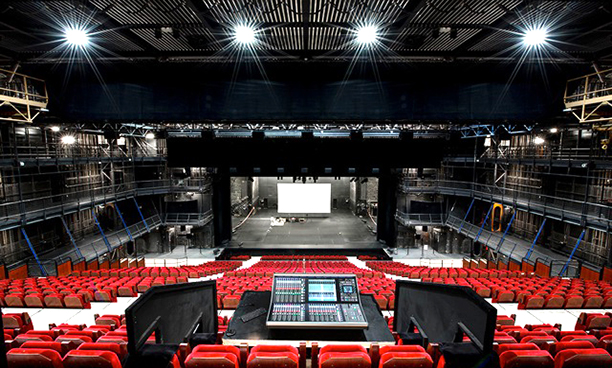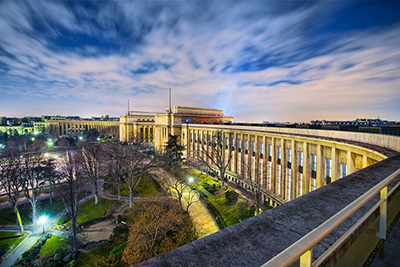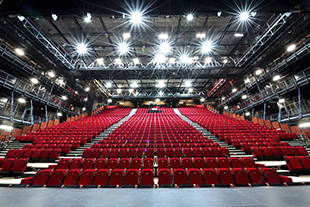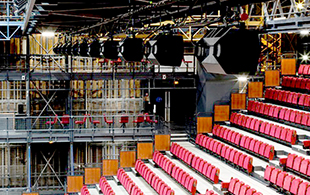
With the sound reinforcement system in Paris’ prestigious Théâtre National de Chaillot’s Jean Vilar Hall due to be replaced, French manufacturer Amadeus Audio imagined a solution that would go beyond the limits of traditional technologies such as stereo, 5.1 surround or any conventional system.
Alongside its studio monitors, Amadeus has established itself as a premiere manufacturer of high-end systems for live and installed sound throughout Europe and Asia. At the Théâtre National de Chaillot, Amadeus has conspired with mixing console manufacturer Solid State Logic, amplifier company Lab.gruppen and 3D sound pioneer Sonic Emotion over a one-of-a-kind electro-acoustic sound system.
 Set in one of the most historical and prestigious concert halls in France, the system that they have developed for the 1,270-capacity hall uses Wave Field Synthesis (WFS) technology. Like visual holograms, this holophonic process captures or creates a sound stage by preserving spatial information: the distance and direction of the sound sources used. ‘This technique allows to replicate the sound field’s physical properties. Wherever they are in the theatre, the listener keeps a coherent perception of the sources’ localisation,’ explains Théâtre National de Chaillot Sound Department Manager, Marc Piera.
Set in one of the most historical and prestigious concert halls in France, the system that they have developed for the 1,270-capacity hall uses Wave Field Synthesis (WFS) technology. Like visual holograms, this holophonic process captures or creates a sound stage by preserving spatial information: the distance and direction of the sound sources used. ‘This technique allows to replicate the sound field’s physical properties. Wherever they are in the theatre, the listener keeps a coherent perception of the sources’ localisation,’ explains Théâtre National de Chaillot Sound Department Manager, Marc Piera.
‘I personally consider that the systems using a single-dimension speaker network, like line arrays, are inept for sound reinforcement in most theatre buildings,’ he continues. ‘These systems were primarily designed for open field concerts, where the audience area is very wide and very deep, and most of the time, on a flat or lightly sloped ground. They create a uniform sound pressure field, but most often they degrade the sound image for most of the audience. The Jean Vilas hall’s intrinsic technical, acoustical, physical and mechanical properties led us to prefer an original sound reinforcement system, based on a holophonic concept. Listening conditions are thus identical for all spectators, wherever they are in the hall.’
The Jean Vilar hall’s bleachers are segmented in four sub-spaces, each of different dimensions, seat numbers and slopes. The bleacher’s curvature is almost exponential, with 16°, 23°, 25° and 35° slopes. The control room sits 12m above the ground, while the spectator area cover 1,122-sq-m (33m-deep, 34m-width).
‘A traditional line source system, with constant or variable curvature, placed in a classical configuration, would inevitably have affected the sources’ localisation, in accordance with the Haas’ Effect,’ Piera continues. ‘In the 1940s, this German scientist established that a source’s localisation is given by the direction of the first sound reaching the ear (direct sound). If the difference between the spectator’s position, the primary source and the secondary source grows, the this effect becomes stronger.’
Based on Huygens’ Principle (1678), the Wave Field Synthesis concept was developed in the Netherlands in the 1980s by the Delft University of Technology. WFS concept makes it possible to synthesise ‘sound holograms’ by simulating acoustic waves produced by virtual sound sources. To do this, the system uses a large number of loudspeakers, regularly spaced and used conjointly. They are each controlled with a delay and a gain to form a wave that emanates from the desired location of the virtual source. This process is repeated for each sound source in the sound scene. The major benefit of the WFS technique is to create a coherent sound field in an extensive area, therefore preserving the fidelity of the spatial image – the position of the sources – even for listeners located at the periphery of the zone or for listeners moving within the zone.
‘Edgard Varèse, one of the 20th century’s pioneering composers in terms of sound spatialisation, said a century ago: “tomorrow’s music will be spatial”,’ says Amadeus R&D Manager, Michel Deluc. “At Amadeus, we have believed in this statement since the Company’s beginnings, in 1992. We worked with the Institut de Recherche et Coordination Acoustique/Musique (IRCAM), to develop the multichannel sound spatialisation equipment used in their Espace de Projection (ESPRO). This led us to develop the install’s 339 custom-made loudspeakers. Transposing this technology for the Théâtre National de Chaillot, thus allowing large audiences to experience it, is a thrilling and edifying challenge.’
The Théâtre system
 ‘We intended to replace our sound reinforcement system, which had not been completely satisfying until now,’ explains Théâtre National de Chaillot Technical Manager, Denis Desanglois. ‘We wished to abandon the stereophonic paradigm, the line array-type. So we implemented a WFS-based system prototype and asked the companies we were working with for their feedback. Some technicians were totally initially disoriented, but eventually everyone was happy, technicians and artists alike. The sensations of listening are completely different, wherever you are in the hall, you experience the same sound – and that’s pretty amazing.
‘We intended to replace our sound reinforcement system, which had not been completely satisfying until now,’ explains Théâtre National de Chaillot Technical Manager, Denis Desanglois. ‘We wished to abandon the stereophonic paradigm, the line array-type. So we implemented a WFS-based system prototype and asked the companies we were working with for their feedback. Some technicians were totally initially disoriented, but eventually everyone was happy, technicians and artists alike. The sensations of listening are completely different, wherever you are in the hall, you experience the same sound – and that’s pretty amazing.
‘We even integrated a 24-speaker ramp in the front end of the stage, to avoid the usual ‘sound hole’ first row of seats,’ he adds.
The installation involves a first line of passive coaxial loudspeakers that is integrated in the front edge of the stage. These 24 loudspeakers – variants of Amadeus PMX 4 model – form a large-scale “sound bar” that is are evenly distributed across 18m, with 75cm between each adjacent speaker. This first line covers the first row of seats.
‘Since the Renaissance, people placed close to the stage are, paradoxically, the less privileged spectators,’ Piera observes. ‘Limelight, candlesticks or oil lamps, generated a dense fog, intruding between spectators and the stage. A few centuries later, this fog left, only to place a “sound hole” there for the same spectators. Electro-acoustical sound reinforcement aimed for these first-row spectators is often too inefficient, if not missing. Staging allowing, a small front fill speaker is tolerated at best. Here, Amadeus’ sound ramp is seamlessly integrated to the location’s scenography, and it’s perfectly dimensioned for our purposes; it redefines the perception of sound and, at last, offers these spectators a real sound and sensory privilege.’
The second line of loudspeakers comprises 11 Amadeus UDX 15 active coaxial speakers, with remote bi-amplification. These are evenly spaced across 23.5m and are placed at 9m height. This line covers the first two thirds of the bleachers. A third line of 11 Amadeus UDX 12 active coaxial speakers with remote bi-amplification is hung to the second technical bridge. These loudspeakers are evenly spaced across 23.5m at a height of 9m. This line covers the first two thirds of the bleachers. A fourth ‘surround’ line is made of six Amadeus UDX 12 active coaxial speakers, with remote bi-amplification. These are hung to the second technical bridge. A unique bass reinforcement system is set up on lateral first level technical bridges, on left and right-hand sides. It is made of six Amadeus Maestro subwoofers, each hosting two long-excursion speakers, loaded by a folded hyperbolic horn. Rear acoustic wave rejection is optimised via a specific baffle.
This sound system is completed with an SSL Live L300 digital mixing console, used with two Network I/O SB 8.8 (eight analogue I/O each) and two Network I/O SB i16 (16 analogue inputs each) Dante stageboxes. The system is completed by a Sonic Emotion Wave II 3D sound processor (64/64 Mido I/O) processor.
 ‘With Dante media networking technology, Audinate is clearly the leader now, with more than 350 manufacturers and more than 800 Dante-enabled products,’ says SSL International Sales Director and SSL France Manager, Philippe Guerinet. ‘The approach is innovative, reliable and affordable in every aspect, and the Théâtre National de Chaillot install is an excellent illustration of this.’
‘With Dante media networking technology, Audinate is clearly the leader now, with more than 350 manufacturers and more than 800 Dante-enabled products,’ says SSL International Sales Director and SSL France Manager, Philippe Guerinet. ‘The approach is innovative, reliable and affordable in every aspect, and the Théâtre National de Chaillot install is an excellent illustration of this.’
‘Audio over IP allows us to put the stageboxes where needed, with minimal and redundant cabling, and to connect on the network all kinds of Dante-enabled gear: Amadeus sound reinforcement system, SSL L300 mixing console, SSL Network I/O stageboxes, and every other ancillary equipment needed. This network approach notably allows us to solve classic problems, like signal distribution without adding any TDM routers; there’s no loss, either noise induced in the audio signals, and latency is particularly low. Last but not least, the technical solutions chosen by the Théâtre National de Chaillot ensure total flexibility and an astonishing audio quality, for a surprisingly affordable budget,’ states Guerinet.
‘The design philosophy brought by Amadeus and Solid State Logic, with their sonic signature and their prestigious pedigrees, allow us to with studio monitoring-grade sound extended to a very large scale, and to innovate with the sound at the very heart of the artistic creation,’ says Sound Stage Manager Séverine Krouch.
‘The Théâtre National de Chaillot is one of the five national French theatres,’ says Denis Desanglois. ‘For a long time, it was an iconic “theatre for the people” symbol, linked with famous names like Jean Vilar then Antoine Vitez. This place offers a large stage for dancers, with a viewing angle and a visibility on a par with their vitality. Our continuing mission is to develop and to support creation and diffusion of the works, and to foster their encounter with the widest audience possible.’
The new 3D sound system has already been used in the production of original contemporary dance productions featuring choreographers, dancers and actors including, Olivia Ruiz, Jean-Claude Gallotta, Carolyn Carlson, Aesoon Ahn, Antony Hamilton, José Montalvo, Thomas Lebrun and Rocio Molina.












